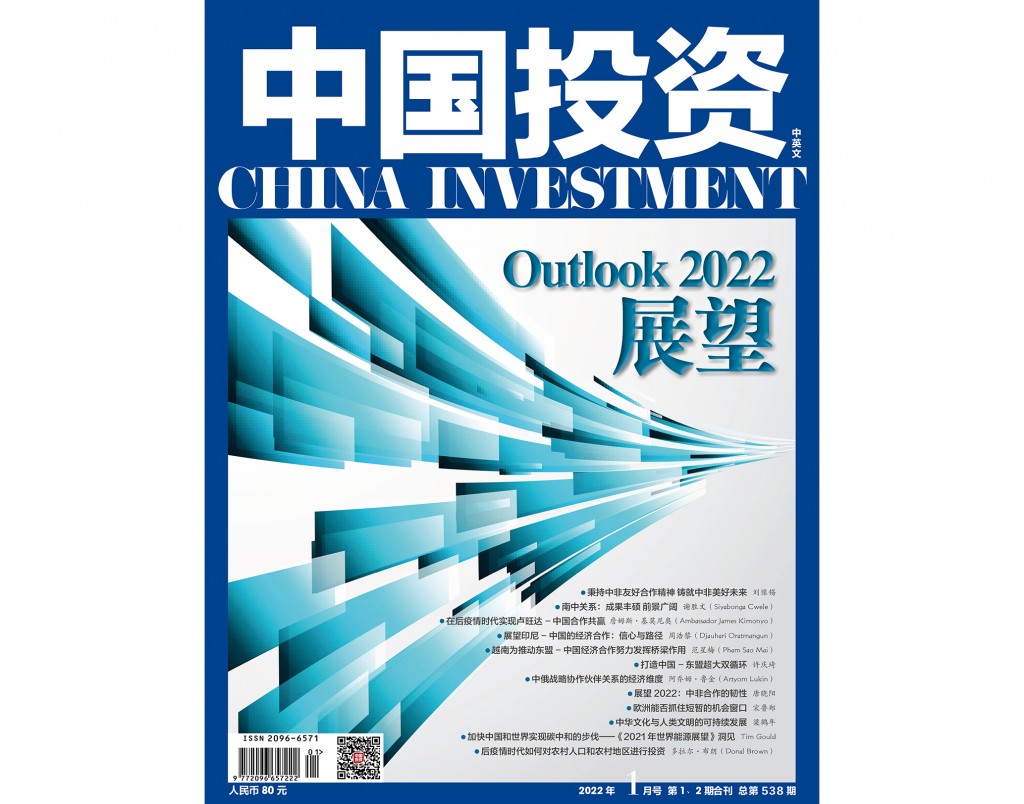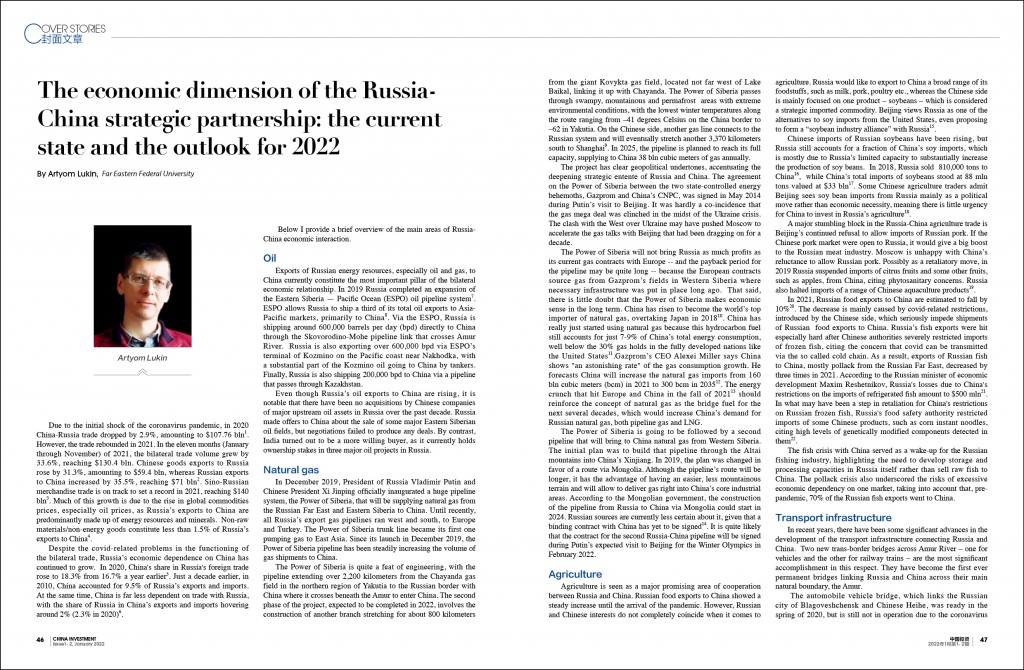
1月封面文章
2022展望
By Artyom Lukin, Far Eastern Federal University
文|阿乔姆·鲁金(Artyom Lukin) 俄罗斯远东联邦大学(Far Eastern Federal University)
导读
●石油
●天然气
●农业
●交通基础设施
The economic dimension of the Russia-China strategic partnership: the current state and the outlook for 2022
Due to the initial shock of the coronavirus pandemic, in 2020 China-Russia trade dropped by 2.9%, amounting to $107.76 bln. However, the trade rebounded in 2021. In the eleven months (January through November) of 2021, the bilateral trade volume grew by 33.6%, reaching $130.4 bln. Chinese goods exports to Russia rose by 31.3%, amounting to $59.4 bln, whereas Russian exports to China increased by 35.5%, reaching $71 bln. Sino-Russian merchandise trade is on track to set a record in 2021, reaching $140 bln. Much of this growth is due to the rise in global commodities prices, especially oil prices, as Russia’s exports to China are predominantly made up of energy resources and minerals. Non-raw materials/non-energy goods constitute less than 1.5% of Russia’s exports to China.
Despite the covid-related problems in the functioning of the bilateral trade, Russia’s economic dependence on China has continued to grow. In 2020, China’s share in Russia’s foreign trade rose to 18.3% from 16.7% a year earlier. Just a decade earlier, in 2010, China accounted for 9.5% of Russia’s exports and imports. At the same time, China is far less dependent on trade with Russia, with the share of Russia in China’s exports and imports hovering around 2% (2.3% in 2020).
Below I provide a brief overview of the main areas of Russia-China economic interaction.
⬆ On November 29, 2021, the first batch of Russian major components for Xudabao Nuclear Power Station of China-Russia Cooperation get through the customs. (Photo/Yang Qing/Xinhau)
Exports of Russian energy resources, especially oil and gas, to China currently constitute the most important pillar of the bilateral economic relationship. In 2019 Russia completed an expansion of the Eastern Siberia — Pacific Ocean (ESPO) oil pipeline system. ESPO allows Russia to ship a third of its total oil exports to Asia-Pacific markets, primarily to China. Via the ESPO, Russia is shipping around 600,000 barrels per day (bpd) directly to China through the Skovorodino-Mohe pipeline link that crosses Amur River. Russia is also exporting over 600,000 bpd via ESPO’s terminal of Kozmino on the Pacific coast near Nakhodka, with a substantial part of the Kozmino oil going to China by tankers. Finally, Russia is also shipping 200,000 bpd to China via a pipeline that passes through Kazakhstan.
Even though Russia’s oil exports to China are rising, it is notable that there have been no acquisitions by Chinese companies of major upstream oil assets in Russia over the past decade. Russia made offers to China about the sale of some major Eastern Siberian oil fields, but negotiations failed to produce any deals. By contrast, India turned out to be a more willing buyer, as it currently holds ownership stakes in three major oil projects in Russia.
Natural gas
In December 2019, President of Russia Vladimir Putin and Chinese President Xi Jinping officially inaugurated a huge pipeline system, the Power of Siberia, that will be supplying natural gas from the Russian Far East and Eastern Siberia to China. Until recently, all Russia’s export gas pipelines ran west and south, to Europe and Turkey. The Power of Siberia trunk line became its first one pumping gas to East Asia. Since its launch in December 2019, the Power of Siberia pipeline has been steadily increasing the volume of gas shipments to China.
The Power of Siberia is quite a feat of engineering, with the pipeline extending over 2,200 kilometers from the Chayanda gas field in the northern region of Yakutia to the Russian border with China where it crosses beneath the Amur to enter China. The second phase of the project, expected to be completed in 2022, involves the construction of another branch stretching for about 800 kilometers from the giant Kovykta gas field, located not far west of Lake Baikal, linking it up with Chayanda. The Power of Siberia passes through swampy, mountainous and permafrost areas with extreme environmental conditions, with the lowest winter temperatures along the route ranging from –41 degrees Celsius on the China border to –62 in Yakutia. On the Chinese side, another gas line connects to the Russian system and will eventually stretch another 3,370 kilometers south to Shanghai. In 2025, the pipeline is planned to reach its full capacity, supplying to China 38 bln cubic meters of gas annually.
The project has clear geopolitical undertones, accentuating the deepening strategic entente of Russia and China. The agreement on the Power of Siberia between the two state-controlled energy behemoths, Gazprom and China’s CNPC, was signed in May 2014 during Putin’s visit to Beijing. It was hardly a co-incidence that the gas mega deal was clinched in the midst of the Ukraine crisis. The clash with the West over Ukraine may have pushed Moscow to accelerate the gas talks with Beijing that had been dragging on for a decade.
The Power of Siberia will not bring Russia as much profits as its current gas contracts with Europe — and the payback period for the pipeline may be quite long — because the European contracts source gas from Gazprom’s fields in Western Siberia where necessary infrastructure was put in place long ago. That said, there is little doubt that the Power of Siberia makes economic sense in the long term. China has risen to become the world’s top importer of natural gas, overtaking Japan in 2018. China has really just started using natural gas because this hydrocarbon fuel still accounts for just 7-9% of China’s total energy consumption, well below the 30% gas holds in the fully developed nations like the United States.Gazprom’s CEO Alexei Miller says China shows “an astonishing rate” of the gas consumption growth. He forecasts China will increase the natural gas imports from 160 bln cubic meters (bcm) in 2021 to 300 bcm in 2035. The energy crunch that hit Europe and China in the fall of 2021 should reinforce the concept of natural gas as the bridge fuel for the next several decades, which would increase China’s demand for Russian natural gas, both pipeline gas and LNG.
The Power of Siberia is going to be followed by a second pipeline that will bring to China natural gas from Western Siberia. The initial plan was to build that pipeline through the Altai mountains into China’s Xinjiang. In 2019, the plan was changed in favor of a route via Mongolia. Although the pipeline’s route will be longer, it has the advantage of having an easier, less mountainous terrain and will allow to deliver gas right into China’s core industrial areas. According to the Mongolian government, the construction of the pipeline from Russia to China via Mongolia could start in 2024. Russian sources are currently less certain about it, given that a binding contract with China has yet to be signed. It is quite likely that the contract for the second Russia-China pipeline will be signed during Putin’s expected visit to Beijing for the Winter Olympics in February 2022.
Agriculture
Agriculture is seen as a major promising area of cooperation between Russia and China. Russian food exports to China showed a steady increase until the arrival of the pandemic. However, Russian and Chinese interests do not completely coincide when it comes to agriculture. Russia would like to export to China a broad range of its foodstuffs, such as milk, pork, poultry etc., whereas the Chinese side is mainly focused on one product – soybeans – which is considered a strategic imported commodity. Beijing views Russia as one of the alternatives to soy imports from the United States, even proposing to form a “soybean industry alliance” with Russia.
Chinese imports of Russian soybeans have been rising, but Russia still accounts for a fraction of China’s soy imports, which is mostly due to Russia’s limited capacity to substantially increase the production of soy beans. In 2018, Russia sold 810,000 tons to China, while China’s total imports of soybeans stood at 88 mln tons valued at $33 bln. Some Chinese agriculture traders admit Beijing sees soy bean imports from Russia mainly as a political move rather than economic necessity, meaning there is little urgency for China to invest in Russia’s agriculture.
A major stumbling block in the Russia-China agriculture trade is Beijing’s continued refusal to allow imports of Russian pork. If the Chinese pork market were open to Russia, it would give a big boost to the Russian meat industry. Moscow is unhappy with China’s reluctance to allow Russian pork. Possibly as a retaliatory move, in 2019 Russia suspended imports of citrus fruits and some other fruits, such as apples, from China, citing phytosanitary concerns. Russia also halted imports of a range of Chinese aquaculture products.
In 2021, Russian food exports to China are estimated to fall by 10%. The decrease is mainly caused by covid-related restrictions, introduced by the Chinese side, which seriously impede shipments of Russian food exports to China.
Russia’s fish exports were hit especially hard after Chinese authorities severely restricted imports of frozen fish, citing the concern that covid can be transmitted via the so called cold chain. As a result, exports of Russian fish to China, mostly pollack from the Russian Far East, decreased by three times in 2021. According to the Russian minister of economic development Maxim Reshetnikov, Russia’s losses due to China’s restrictions on the imports of refrigerated fish amount to $500 mln. In what may have been a step in retaliation for China’s restrictions on Russian frozen fish, Russia’s food safety authority restricted imports of some Chinese products, such as corn instant noodles, citing high levels of genetically modified components detected in them.
The fish crisis with China served as a wake-up for the Russian fishing industry, highlighting the need to develop storage and processing capacities in Russia itself rather than sell raw fish to China. The pollack crisis also underscored the risks of excessive economic dependency on one market, taking into account that, pre-pandemic, 70% of the Russian fish exports went to China.
Transport infrastructure
In recent years, there have been some significant advances in the development of the transport infrastructure connecting Russia and China. Two new trans-border bridges across Amur River – one for vehicles and the other for railway trains – are the most significant accomplishment in this respect. They have become the first ever permanent bridges linking Russia and China across their main natural boundary, the Amur.
The automobile vehicle bridge, which links the Russian city of Blagoveshchensk and Chinese Heihe, was ready in the spring of 2020, but is still not in operation due to the coronavirus epidemiological restrictions imposed by Chinese authorities. When fully operational, the toll bridge will be able to handle 630 trucks, 154 buses and 68 cars a day. The bridge will allow an eight-fold increase in the cargo traffic turnover between Blagoveshchensk and Heihe, from the current 500,000 tons to 4 mln tons.
The rail bridge across the Amur, linking Nizhneleninskoye on the Russian side with Tunjiang on the Chinese side, is in the final stages of construction, expected to be completed by the spring of 2022. Its initial capacity is 5.2 mln tons a year, which can be expanded to 20 mln tons. The bridge will mostly be used to export to China commodities from the Russian Far East, mainly coal, iron ore, fertilizer, and timber.
It is significant that both bridges were constructed on the basis of parity. China did the construction work on its side of the border, while Russia was responsible for the works on its side. The funding also came from both China and Russia. In the case of the Nizhneleninskoye-Tunjiang railway bridge, China and Russia, respectively, financed their halves of the project. With regard to the Blagoveshchensk – Heihe bridge, the financing scheme was more complicated. China fully funded its half of the bridge, while the construction on the Russian side was financed through a specially-created Russian-Chinese company that got a loan from a bank in Heilongjiang. Russia itself did not spend any public money on the bridge. The Heilongjiang authorities initially demanded that the entire bridge be built by Chinese companies, given that the financing was provided by a Chinese bank. However, the Russian side did not agree to this demand, insisting that the Russian side of the bridge should be built by Russian contractors. Such a stance reflects Russia’s emphasis on equality with China in the face of China’s superior economic capabilities.
While China has invested money in the trans-border bridges, it is still reluctant to commit to transport infrastructure projects inside the Russian territory. Despite efforts by Russian authorities to attract Chinese investment into the development of transport infrastructure, China has not yet spent a single yuan on transport infrastructure projects in Russia. A case in point is the continued absence of Chinese investments in the international transport corridors Primorye-1 and Primorye-2 that are mainly designed to give the provinces of Heilongjiang and Jilin direct access to the Russian ports on the Sea of Japan’s coast. Russian deputy prime minister Yuri Trutnev, who leads negotiations with China over the Primorye-1 and Primorye-2, has repeatedly expressed disappointment over the lack of “a clearly formulated position” by Chinese on the development of the corridors. Even though China keeps saying it is interested in transport corridors via the Russian Far East, it avoids taking any specific commitments with respect to investment or the volume of Chinese cargos to pass through the corridors. One major reason for Chinese reluctance to finance Russian infrastructure projects is China’s desire to have ownership and management control over them, which Russian authorities are unwilling to grant.
Russia does benefit from China’s drive for more transport connectivity in Eurasia under the Belt and Road initiative. This is thanks to the role of Russia’s rail network as an important link in the China – Europe overland freight routes. In 2020, the total number of freight trains from China to Europe rose 50% — and was up sevenfold since 2016. In 2021, the Russian Railways reported a 47% rise in the volume of container cargos from China transiting Russia en route to Europe. Most of this China-Europe traffic goes via Kazakhstan and Russia, because these two Eurasian countries provide the shortest land route from China to Europe. In 2020, the volume of traffic between China and Europe via the Russian railways doubled. The Evergiven accident of March 2021 that temporarily blocked the Suez Canal highlighted the importance of alternative routes, including trans-Eurasian continental corridors, for global trade.
Russia also hopes to capitalize on the Northern Sea Route (NSR) as Arctic waters are expected to become more navigable with the global warming and technological advancements. The deputy prime minister Yuri Trutnev, who is in charge of the Russian Far East and the Arctic, predicts that, by 2023, Russia’s Northern Sea Route will provide year-round commercial navigation and become a competitor to the Suez route. Russia’s ambitions with respect to the NSR seem to be compatible with China’s Polar Silk Road. However, as with other Russia’s mega projects in the sphere of transport connectivity, China is not in a hurry to fund the expensive infrastructure required to turn the NSR into a major commercial sea lane. It remains to be seen if, when, and under what terms China joins Russia’s NSR projects.
Conclusion
The Russia-China economic relationship continues to advance, reflecting the comprehensive strategic partnership of coordination that exists between the two nations. Heading into 2022, there are two issues that need special attention from both sides, as well as their enhanced collaboration. One is the situation regarding the cross-border trade. The coronavirus pandemic has wreaked havoc on cross-border commerce between Russia and China and stalled development of the cross-border infrastructure. In particular, the pandemic is delaying the launch of the Blagoveshchensk-Heihe bridge, whose construction was finished in 2020. The other is the potential risk of Russia being disconnected from SWIFT: amidst heightened tensions over Ukraine the United States has repeatedly threatened to block Russia from the international financial systems. Russia and China should be ready for such worst-case scenarios so as to ensure their bilateral economic interaction is not disrupted by American and EU sanctions. In particular, Russia and China should accelerate efforts to reduce dependence on Western-dominated financial mechanisms.

在新冠疫情突如其来的冲击下,2020年中俄贸易额总计1077.6亿美元,同比下降2.9%。而在2021年,中俄贸易则显著回升——2021年1月至11月,中俄贸易额已达1304亿美元,同比增长33.6%;中国对俄罗斯出口增长31.3%,达到594亿美元,而俄罗斯对中国出口增长35.5%,达到710亿美元。如此看来,中俄2021年货物贸易总额预计达到1400亿美元,有望创历史新高。中俄贸易增长很大程度应归功于全球商品价格的上涨,尤其是国际油价上涨。这是因为在俄罗斯对华出口商品中,大部分是能源和矿产资源;非原料产品与非能源产品仅占俄罗斯对华出口的1.5%。
尽管疫情一度影响中俄双边贸易运转,俄罗斯对中国的经济依赖却在继续加深:2019年,对华贸易额在俄罗斯对外贸易总额中占比16.7%,这一比重在2020年增至18.3%;而在十年前,也就是2010年,对华贸易额在俄罗斯进出口总额中还仅占9.5%。与此同时,中国对俄罗斯贸易的依赖程度却远没有如此之高:对俄贸易在中国进出口总额中的比重一直浮动在2%左右(这一比重在2020年为2.3%)。
在下文中,我将就中俄经济合作互动的几大领域进行简要概述。
石油
在当下,中俄双边经济关系中最重要的支柱,莫过于俄罗斯对中国的能源出口,尤其是石油和天然气出口。在2019年,俄罗斯完成了一项对“东西伯利亚–太平洋”(Eastern Siberia – Pacific Ocean,ESPO)输油管道的扩建工程。这条管道使俄罗斯石油出口总量的三分之一能够运抵亚太市场,其中大部分则运往中国。具体而言,沿东西伯利亚–太平洋管道的“斯科沃罗季诺–漠河”(Skovorodino-Mohe)支线,俄罗斯石油以60万桶/日(bpd)的运输量穿过黑龙江,直接通往中国。同时,在东西伯利亚–太平洋管道位于太平洋沿岸纳霍德卡港(Nakhodka)附近的科济米诺湾(Kozmino)终点站,也有超过60万桶/日的石油通过油轮运往中国。此外,俄罗斯还以20万桶/日的运输量,借道哈萨克斯坦对华输油。
尽管俄罗斯对华石油出口量不断增加,但一个值得注意的现象是,近十年来还没有中国公司对俄罗斯石油产业的上游资产达成重大收购。尽管俄罗斯曾尝试向中国出售东西伯利亚地区的一些大型油田,但谈判以失败告终,没有达成任何协议。相比之下,印度却表现出更浓厚的收购意愿。如今,在俄罗斯的大型石油项目中,有三个项目都为印度公司持有股权。
天然气
2019年12月,俄罗斯总统弗拉基米尔·普京和中国国家主席习近平正式宣布启动“西伯利亚力量”(Power of Siberia)大型天然气管道系统,从俄罗斯远东经济区和东西伯利亚经济区向中国供应天然气。在此之前,俄罗斯所有的天然气出口管线都是向西或向南,通往欧洲或土耳其。因此,“西伯利亚力量”干线成为了俄罗斯第一条向东亚输气的管道。自2019年12月启动以来,“西伯利亚力量”管道对中国的输气量一直呈稳步增长态势。
“西伯利亚力量”是一项相当了不起的工程壮举,这条管道绵延2200公里,北起俄罗斯北部雅库特地区(Yakutia)的恰扬达(Chayanda)气田,南至中俄边境,并跨越黑龙江,进入中国境内。这一工程的第二期“西伯利亚力量2号”会建设另一支长达800公里的管道支线,以毗邻贝加尔湖西部的巨型气田科维克塔(Kovykta)气田为起点,将其与恰扬达气田相连。“西伯利亚力量”一路横穿沼泽、山地和永冻土层等气候条件严苛的地区,沿线冬季极端最低温度在中俄边境低至零下41℃,在雅库特地区则低至零下62℃。到达中国后,“西伯利亚力量”会与中国境内另一条管道相连,并一路向南,穿越3370公里的距离,最终抵达上海。“西伯利亚力量”预计将在2025年发挥出最大潜力,每年将向中国供应380亿立方米天然气。
“西伯利亚力量”项目具有明显的地缘政治内涵,是中俄战略友好关系(entente)不断深化的象征。正是在普京2014年5月访华期间,中俄两国的国有能源企业巨头——中国石油天然气集团公司(CNPC)和俄罗斯天然气工业股份公司(Gazprom)就“西伯利亚力量”达成了协议。同时,这项天然气“超级协议”的敲定还正逢乌克兰危机关头,这也绝非偶然:中俄之间的天然气谈判已经拖沓了近十年之久,而俄罗斯与西方国家在乌克兰问题上爆发冲突,很可能促使其加快了与中国的谈判进程。
不过,“西伯利亚力量”管道的投资回收期可能会相当长,而且回报率也并不如俄欧现有的天然气合同那样利润丰厚。这是因为,供给欧洲的天然气主要来自于俄气位于西西伯利亚的气田,必要的基础设施已建设完备。但长期而言,“西伯利亚力量”无疑会带来更多经济收益。在2018年,中国已经超过日本,成为世界第一大天然气进口国。然而,中国在天然气应用方面才刚刚起步,目前这种碳氢燃料仅占中国能源消费结构的7%-9%,还远未达到诸如美国等发达国家约30%的水平。俄气首席执行官阿列克谢·米勒(Alexei Miller)表示,中国的天然气消费增长“速度惊人”(an astonishing rate),并预计到2035年,中国天然气进口量将从2021年的1600亿立方米(160bcm)提升至3000亿立方米(300bcm)。此外,中国与欧洲在2021年秋季都遭遇了能源短缺危机。这进一步彰显出天然气成为未来数年能源转型的“过渡能源”或“桥梁能源”(bridge fuel)的可能性。这也意味着中国对俄罗斯天然气的需求,不论是对管道天然气(pipeline gas)还是液化天然气(LNG)的需求,都会进一步上升。
此外,第二条中俄天然气管道也已确定计划。这条管道会跟进“西伯利亚力量”,从西西伯利亚地区向中国输送天然气。最初的规划是建设一条穿越阿尔泰山脉,到达中国新疆的管道;而在2019年,规划开始倾向于借道蒙古国修建管道。尽管新规划的路线长度更长,但避免了在多山地带修建工程的困难,并且能使天然气管道更直接地抵达中国各大核心工业区。蒙古国政府表示,途径蒙古国的中俄管道建设工程计划在2024年开工。不过,一些俄罗斯媒体表示尚不确定该计划能否成行,因为俄罗斯还需要与中国签订一个具有约束力的合同。而这份关于第二条中俄天然气管道的合同,很可能会在普京2022年2月访华并出席北京冬奥会期间签订。
农业
中俄普遍认为,农业是两国充满合作前景的领域之一。而自疫情以来,俄罗斯对华食品出口也呈现出稳定增长趋势。不过,中俄在农业领域的利益并不完全一致:俄罗斯希望对华出口一系列食品,包括奶制品、猪肉、禽类等;而中国却只关注一种产品,即大豆。中国视大豆为一种战略进口商品,并认为俄罗斯可以替代美国,成为中国的进口大豆的供应商。中国甚至还提议与俄罗斯组建一个“大豆产业联盟”(soybean industry alliance)。
中国自俄大豆进口量一直持续增长。但是,由于俄罗斯没有足够能力大幅增加大豆产量,因此在中国的大豆进口总量中,俄罗斯仍然占比甚小。2018年,俄罗斯对华大豆出口量达到了81万吨。然而,当年中国大豆进口总量却足有8800万吨,总价值330亿美元。部分中国农业商企也认为,中国自俄罗斯进口大豆主要是出于政治考量,而非基于迫切的经济需要,这也意味着中国并不急于投资俄罗斯农业。
中俄农业贸易还有一块绊脚石:中国拒绝从俄罗斯进口猪肉。而一旦中国对俄罗斯开放猪肉市场,俄罗斯肉类产业将会得到相当大的提振。因此,中国在放开自俄猪肉进口问题上举棋不定的态度使俄罗斯感到不满。在2019年,很可能是出于报复之举,俄罗斯以植物检疫的名义,暂时限制从中国进口柑橘类以及苹果等水果;此外,俄罗斯还对中国一系列水产品实行了临时进口禁令。
2021年,俄罗斯对华食品出口额预计减少10%。而这主要应归咎于防疫政策,尤其是中方的防疫措施阻碍了俄罗斯食品运抵中国。鉴于新冠病毒通过冷链传播的可能性,中国有关部门对俄罗斯出口的冷冻鱼采取了十分严苛的限制措施,俄罗斯的海产品和鱼类出口也因此受损不小:俄罗斯2021年对华的鱼类出口量降为同期的四分之一,这其中大部分是产自俄罗斯远东经济区的狭鳕鱼(Pollack)。俄罗斯联邦经济发展部部长马克西姆·列舍特尼科夫(Maxim Reshetnikov)指出,中国限制冷冻鱼进口,已经导致俄罗斯经济损失达50亿美元。同样的,或许是为了反制中国对俄罗斯冷冻鱼的进口限制,俄罗斯的食品安全部门也限制了部分中国产品的进口,比如以发现大量转基因成分为由,对中国的玉米面条等食品实行了进口禁令。
对俄罗斯渔业而言,在中国遭遇的进口危机是一个警示。一方面,这提醒俄罗斯有必要加强海产品贮存和加工能力,而不是止步于向中国出口鲜鱼或原料鱼。另一方面,考虑到疫情前,对华鱼类出口量占据了俄罗斯鱼类出口总量的70%,此次狭鳕鱼危机还显示出过度依赖于某一市场的风险。
交通基础设施
近年来,中国与俄罗斯在发展交通基础设施互联互通方面,取得了一系列重大进展。其中,最为显著的成就是两座跨境桥梁:一座是公路大桥,一座是铁路大桥。这两座大桥也成为了跨越中俄自然边界之一的黑龙江、联通两国的第一批永久性桥梁。
其中,公路大桥连接着俄罗斯的布拉戈维申斯克市(Blagoveshchensk)与中国的黑河市。这座桥梁已于2020年建成,但由于中国有关部门实行新冠疫情防控措施,大桥还尚未开通。当这座收费桥完全投入使用后,预计将每天通行630辆卡车、164辆公交车和68辆小轿车,并使布拉戈维申斯克市与黑河市之间的年货运量增长7倍,从现在的50万吨提升至400万吨。
铁路大桥也越过黑龙江两岸,联通着俄罗斯下列宁斯阔耶市(Nizhneleninskoye)与中国黑龙江省同江市。铁路大桥目前已经进入最后收官阶段,预计2022年春季完工。大桥初始年过货能力预计为520万吨,之后有望扩展至2000万吨。大桥将主要用于向中国出口来自俄罗斯远东经济区的商品,包括煤炭、铁矿石、肥料和木材等。
两座大桥还别具意义,因为它们都是基于对等原则(parity),由中俄双方共同修建的。具体而言,大桥以国界线为分界,由中方负责中境内线路的建设,由俄方负责俄境内线路的建设。此外,大桥还由中俄两国共同投资。其中,“下列宁斯阔耶-同江”铁路大桥由中国和俄罗斯分别对自己境内段线路的工程进行投资。而“布拉戈维申斯克-黑河”公路大桥的投资方案则更复杂:中国全额承资本国境内段工程,而俄罗斯境内段的投资主体是一家为此专门成立的中俄合资公司,通过黑龙江省的一家银行贷款,而没有任何俄罗斯的公共资金投入其中。因此,黑龙江有关部门最初提出,鉴于工程资金是一家中方的银行提供的,因此整座桥梁都可以由中方公司承修。但俄方却没有同意中方的要求,并坚持让俄罗斯的承包商修建大桥的俄罗斯境内段。俄方的立场反映出,尽管中国拥有更强的经济实力,但俄罗斯仍强调按照平等原则与中国共事。
尽管中国投资建设了这些中俄跨境大桥,但中国对是否投资俄罗斯境内的交通基础设施建设却仍然游移不定。尽管俄罗斯有关部门努力吸引着中国投资交通基础设施,但在俄罗斯境内的交通基础设施项目中,中国还没有投资。举例而言,俄罗斯计划建设“滨海一号”(Primorye-1)和“滨海二号”(Primorye-2)两条国际货运走廊,将中国黑龙江省和吉林省直接与日本海沿岸的俄罗斯港口联通起来。但至今还没有中国公司投资这两个项目。俄罗斯副总理尤里·特鲁特涅夫(Yuri Trutnev)曾带领代表团与中国就“滨海一号”和“滨海二号”谈判。他多次表示,对中方在建设货运走廊事宜上没能“清晰明示立场”(a clearly formulated position)表示失望。虽然中国一直表示有兴趣建设通往俄罗斯远东经济区的货运通道,但中国却一直回避就投资数额或通过该条通道的中国货运量作出任何具体承诺。其实,中国不愿投资俄罗斯基础设施建设的主要原因之一,是中国希望取得对这些基础设施的产权和经营权,但俄罗斯政府部门却不愿意准予这些权利。
尽管如此,中国“一带一路”倡议中加强亚欧大陆互联互通和交通建设的努力,的的确确使俄罗斯获得了好处。这主要因为,俄罗斯的铁路网是联通中欧两洲货运通道的重要一环:在2020年,中欧班列全年开行数量同比增长50%,是2016年开行量的7倍多。此外,2021年,俄罗斯铁路公司(Russian Railways)报告称,中国与欧洲从俄罗斯过境的货物集装箱数量增加了47%。这是因为,中欧之间交通大部分都要途经哈萨克斯坦和俄罗斯,这两个欧亚(Eurasian)国家为中欧交通提供了距离最近的陆上通道。2020年,中欧之间借道俄罗斯铁路的运输量已经翻了一番。此外,2021年3月“长赐”号(Evergiven)货轮搁浅造成苏伊士运河堵塞的事件更加显示出,建造一条全球贸易的替代路线有多么重要,这对亚欧跨大陆交通走廊尤其如此。
随着全球变暖与技术进步,北极水域预计将变得更加适航,因此,俄罗斯还希望开发“北极航道”(Northern Sea Route,NSR)。负责俄罗斯远东和北极事务的俄罗斯副总理尤里·特鲁特涅夫预测,到2023年,俄罗斯的北极航道将实现全年商用通航,并有望成为苏伊士运河的有力竞争者。此外,俄罗斯的北极航道计划还可以与中国的“冰上丝绸之路”(Polar Silk Road)相结合。然而,与俄罗斯在交通领域的其他重大规划一样,北极航道并没有引来中国的极大兴趣——中国并不急于投资北极航道的巨额基础设施,并不着急将其打造为一条主要商业航运通道。因此,中国何时以及以何种协议加入俄罗斯的北极航道计划,还有待观察。
结论
中俄全面战略协作伙伴关系紧密坚韧,中俄经济关系也在不断发展向前。进入2022年,中俄两国还需要给予以下两个领域更多关注,并进一步加强协作。其一是关于中俄跨境贸易:新冠疫情使中俄跨境贸易损失严重,还拖慢了两国跨境基础设施建设的步伐,尤其是导致早在2020年就建成的布拉戈维申斯克-黑河公路大桥迟迟没能开通。其二事关俄罗斯被切断与SWIFT(环球银行金融电信协会)支付系统联系的可能风险:在乌克兰局势日趋紧张之际,美国多次以把俄罗斯排除在国际金融体系之外相威胁。中俄应当未雨绸缪,做最坏打算,以使美国和欧盟可能施加的制裁不会破坏中俄双边经贸活动;中俄尤其应该加快步伐,减少对以西方为主导的金融机制的依赖。
编辑 | 许成之
翻译 | 张童童
校对 | 闫建军
设计 | 大 米



